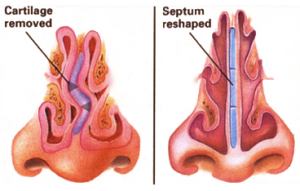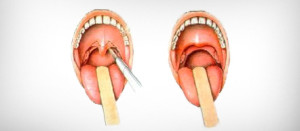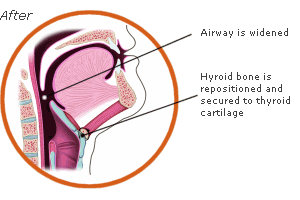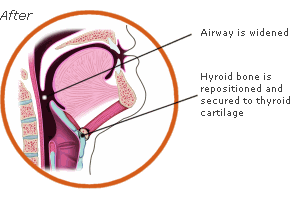Yes, there are many types of surgery for sleep apnea.
What all does sleep apnea surgery entail? What different types of surgery for sleep apnea are there?
The good news is there are many different types of surgery to stop snoring and sleep apnea. We will go into detail of each of these so you can get a better idea of what you can expect.
Did you know that over 50% of compliant sleep apnea patients still do not use CPAP therapy after buying a CPAP machine and mask?
So, you are not alone in searching for other treatment options.
What surgeries are there for sleep apnea?
The most common types of surgery for sleep apnea are:
- Nasal Surgery
- Uvulopalatopharyngoplasty (UPPP)
- Lower Jaw Advancement
- Tongue Advancement
- Tongue Base Reduction
- Palate Implants
- Tracheostomy
- Hyoid Advancement
Now, lets go over these a lot more in detail.
Nasal Surgery
Nasal surgery to stop snoring is common. Obstruction in the nasal area and nasal congestion while you sleep are big factors in causing sleep related breathing problems.
Therefore, treating the nasal area can fix sleep apnea and snoring if nasal issues are your problem. The three areas that may be causing problems in your nose are the nasal valve, septum, and the turbinates.
Usually, surgery is done to reduce the septum and turbinates, called septoplasty and turbinate reduction.
This procedure is an outpatient one and you can normally return home within hours of having the surgery.
After reducing the septum and turbinates it creates more room in your nose which allows more air to pass through smoothly.
Then for some people, there is also a problem with having nasal valve collapse. This is because the lower nasal cartilages are weak and can’t hold open the nostrils.
For people that have this problem, surgery is done to remove the cartilage from the septum and placed accordingly to restrengthen the valve and prevent the collapse from happening.
Uvulopalatopharyngoplasty (UPPP)
UPPP is a very common, in fact the most common, surgery to stop snoring for over 25 years.
We can’t even pronounce Uvulopalatopharyngoplasty or have any idea why it has such a complex name, but we can tell you the long name does not fit for the procedure that is completed.
It simply means the surgeon will remove excess tissue from the soft palate and the pharynx. Also, if you have tonsils they will remove those as well. An ENT can diagnose and do this.
After they remove the excess tissue they place sutures to keep everything open to prevent collapse.
The upper airway (oropharynx) is a very common place for obstruction in people and is the cause of the snoring or sleep apnea.
This surgery will require an overnight stay at the hospital because of all the swelling and time needed for healing.
People have had some huge success with this surgery as it prevents the vibration of the back wall of the pharynx and soft palate.
Lower Jaw Advancement
Some people can fix their snoring by having a lower jaw advancement.
It is common that people with sleep apnea have small or narrow jaws which do not help airflow and can cause obstruction.
This procedure entails advancing or moving the upper and lower jaw bones from 10-12mm.
The jaw is then stabilized in an advanced position with titanium plates.
This procedure is a very difficult one for the surgeon and patient due to the preciseness involved and the pain afterward, but has over a 90% success rate of stopping snoring.
Patients will have to have their mouth wired shut for many weeks to allow the bones to heal.
Yet, very few surgeons perform this surgery due to risks and possible complications.
Tongue Advancement
During this surgery the surgeon will advance the tongue forward by maneuvering the primary tongue muscle (genioglossus).
This will make it to where your tongue can no longer fall backward toward your throat while you sleep.
The surgery consists of cutting the jaw bone in a rectangular shape where the genioglossus muscle is connected.
The bone is then moved forward which also moves the muscle that is attached. A small titanium plate is then used to fix the bone into place to prevent it settling back where it was.
This procedure is done in the same area as a hyoid advancement (mentioned below) and many studies have shown it to be very successful.
Yet, this surgery requires you to stay all night at the hospital unlike the hyoid because it takes longer for healing.
Tongue Base Reduction
The tongue, as you can see, is common in being the source of the problem since this is the 2nd tongue procedure.
In this surgery, the tissues of the tongue will be reduced/taken away and is a very effective sleep apnea surgery option to stop snoring.
One way they can do this is by using radio frequency waves that will shrink the tissue at the base of the tongue.
This procedure can even be done while you are awake as it is not that serious. Yet, several treatments will have to be done.
The other method is of course manually removing some of the tissue at the base of the tongue, also called midline glossectomy.
However, this surgery is done with general anesthesia at the hospital.
You will also have to stay overnight, normally, so they can observe the affects of the procedure (to see if it is working correctly or not).
Again, both these methods have been studied to be very effective.
Palate Implants (The Pillar Procedure)
Palate implants, or The Pillar Procedure, is a not-so-serious surgery that can help sleep apnea or snoring also.
The surgeon will place 3 polyester rods into the soft palate.
The result is after the rods have been placed, the soft palate will react in an inflammatory response that results in the soft palate stiffening.
Since the soft palate is stiffer, it is less likely to contact the pharynx wall during sleep when your muscles are relaxed.
Therefore, causing sleep apnea episodes or snoring to seize. This surgery is generally done with local anesthesia in an office setting while you are awake.
Tracheostomy
A tracheostomy involves the trachea, as you would guess, and creates a passage for airflow directly to the lungs from the trachea in your neck.
This is pretty much creating a bypass in your airway to avoid any obstructions from the upper airway.
This is normally only done long-term for severely obese patients who have failed at all other attempts of surgery treatments.
Though, it is not ideal, it is more effective than any other surgery treatment and is used with very sick people.
Hyoid Advancement
The hyoid bone is the source of treatment in this surgery. The hyoid bone is located in your neck where the tongue muscles and pharynx connect.
Often, people with sleep apnea have a big tongue base.
During sleep, muscles relax and the base of the tongue starts to fall backward and contact the pharynx back wall which causes the obstruction.
This procedure is not invasive at all with the hyoid bone being altered by putting a suture around it so that it can suspend in front of the jaw bone.
As a result, the airway is expanded and it prevents collapse. Usually, this requires 2 small incisions in the neck area and is done in less than an hour.
You will get to go home immediately afterward and it is not that painful at all.
Success rates of this procedure are huge and recently been a go-to procedure for many surgeons.
Conclusion
We hope you have a better idea of all the procedures involved in the different types sleep apnea surgery.
If you are sick of using a cpap mask or just want to quit snoring, then some of these procedures can be talked about with your doctor.
Choosing a procedure that you want is usually not going to happen unless you are fortunate and different ones can fix the same problem.
Normally, the doctor will have to do some tests to figure out what procedure may be best for you. And in some cases, multiple ones may be required.
The good news is that cpap therapy can be avoided if you are willing to go through some surgeries and spend the money.

